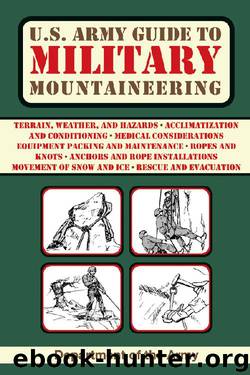U.S. Army Guide to Military Mountaineering by Department Of The Army

Author:Department Of The Army [Army, Department Of The]
Language: eng
Format: epub
Publisher: Skyhorse Publishing (Perseus)
Published: 2013-12-31T22:00:00+00:00
Figure 6-11. Examples of jam holds.
6-10. COMBINATION TECHNIQUES
The positions and holds previously discussed are the basics and the ones most common to climbing. From these fundamentals, numerous combination techniques are possible. As the climber gains experience, he will learn more ways to position the hands, feet, and body in relation to the holds available; however, he should always strive to climb with his weight on his feet from a balanced stance.
a. Sometimes, even on an easy route, the climber may come upon a section of the rock that defies the basic principles of climbing. Short of turning back, the only alternative is to figure out some combination technique that will work. Many of these type problems require the hands and feet to work in opposition to one another. Most will place more weight on the hands and arms than is desirable, and some will put the climber in an “out of balance” position. To make the move, the climber may have to “break the rules” momentarily. This is not a problem and is done quite frequently by experienced climbers. The key to using these type of combination techniques is to plan and execute them deliberately, without lunging or groping for holds, yet quickly, before the hands, arms, or other body parts tire. Still, most of these maneuvers require good technique more than great strength, though a certain degree of hand and arm strength certainly helps.
b. Combination possibilities are endless. The following is a brief description of some of the more common techniques.
(1) Change Step. The change step, or hop step, can be used when the climber needs to change position of the feet. It is commonly used when traversing to avoid crossing the feet, which might put the climber in an awkward position. To prevent an off balance situation, two solid handholds should be used. The climber simply places his weight on his handholds while he repositions the feet. He often does this with a quick “hop,” replacing the lead foot with the trail foot on the same hold. Keeping the forearms against the rock during the maneuver takes some of the strain off the hands, while at the same time strengthening the grip on the holds.
(2) Mantling. Mantling is a technique that can be used when the distance between the holds increases and there are no immediate places to move the hands or feet. It does require a ledge (mantle) or projection in the rock that the climber can press straight down upon. (Figure 6-12, page 6-20, shows the mantling sequence.)
(a) When the ledge is above head height, mantling begins with pull holds, usually “hooking” both hands over the ledge. The climber pulls himself up until his head is above the hands, where the pull holds become push holds. He elevates himself until the arms are straight and he can lock the elbows to relax the muscles. Rotating the hands inward during the transition to push holds helps to place the palms more securely on the ledge. Once the arms are locked, a foot can be raised and placed on the ledge.
Download
This site does not store any files on its server. We only index and link to content provided by other sites. Please contact the content providers to delete copyright contents if any and email us, we'll remove relevant links or contents immediately.
| Excursion Guides | Mountain Climbing |
| Rock Climbing |
Annapurna by Maurice Herzog(2839)
Into Thin Air by Jon Krakauer(2701)
SAS Survival Handbook by John 'Lofty' Wiseman(2259)
The Ogre by Doug Scott(2114)
Reservoir 13 by Jon McGregor(1852)
Everest the Cruel Way by Joe Tasker(1827)
The End of Eddy by Édouard Louis(1746)
Touching the Void by Joe Simpson(1706)
The Push by Tommy Caldwell(1685)
Iced In by Chris Turney(1579)
The Call of Everest by Conrad Anker(1550)
The Isle of Mull by Terry Marsh(1517)
Miracle in the Andes by Nando Parrado(1494)
Touching the Void (1987) by Joe Simpson(1413)
Mud, Sweat, and Tears by Bear Grylls(1300)
Himalaya Bound by Michael Benanav(1256)
Higher Calling by Max Leonard(1241)
Death Grip by Matt Samet(1160)
Backcountry Bear Basics by Dave Smith(1128)
